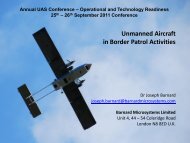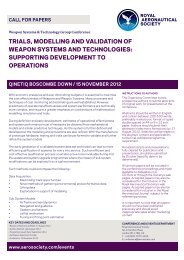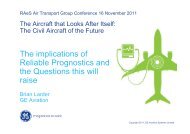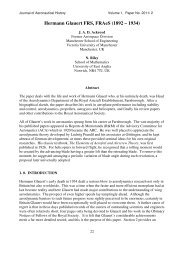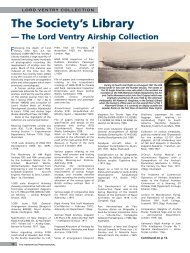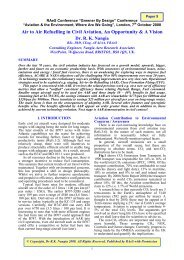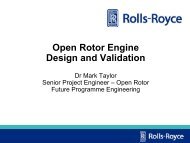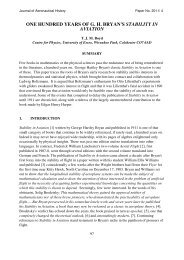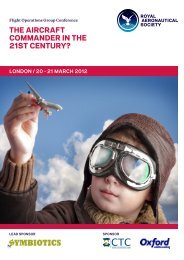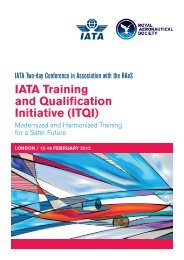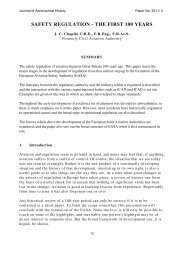Smoke, Fire and Fumes in Transport Aircraft - Royal Aeronautical ...
Smoke, Fire and Fumes in Transport Aircraft - Royal Aeronautical ...
Smoke, Fire and Fumes in Transport Aircraft - Royal Aeronautical ...
Create successful ePaper yourself
Turn your PDF publications into a flip-book with our unique Google optimized e-Paper software.
APPENDIX 6<br />
UNITED KINGDOM UK CAA GUIDANCE<br />
AERONAUTICAL INFORMATION CIRCULAR<br />
AIC 131/1999 (P<strong>in</strong>k 203)<br />
THE NEED TO AVOID DELAY WHEN AN IMMEDIATE LANDING APPEARS NECESSARY<br />
1. Introduction<br />
1.1 When faced with a situation <strong>in</strong> which it is evident that a flight cannot cont<strong>in</strong>ue as planned, the comm<strong>and</strong>er will first have to decide whether<br />
some delay before l<strong>and</strong><strong>in</strong>g is acceptable or whether the aircraft should be l<strong>and</strong>ed — safely — as soon as possible.<br />
1.2 If the circumstances are such that an immediate l<strong>and</strong><strong>in</strong>g does not appear necessary, the comm<strong>and</strong>er will most likely have sufficient time<br />
to select an airfield that best suits his requirements <strong>and</strong> then plan for the descent, approach <strong>and</strong> l<strong>and</strong><strong>in</strong>g without experienc<strong>in</strong>g undue pressure.<br />
However, if the circumstances are such that an immediate l<strong>and</strong><strong>in</strong>g does appear necessary, aim<strong>in</strong>g to l<strong>and</strong> at the nearest suitable airfield may<br />
br<strong>in</strong>g with it problems that are unlikely to be faced <strong>in</strong> normal operations.<br />
1.3 One such problem associated with a decision to l<strong>and</strong> as soon as possible might be the prospect of l<strong>and</strong><strong>in</strong>g overweight. For the crew, this<br />
should require little more than complet<strong>in</strong>g an appropriate checklist, confirm<strong>in</strong>g that the airfield <strong>in</strong>tended to be used is suitable (hav<strong>in</strong>g regard<br />
to the performance of the aircraft <strong>in</strong> the circumstances encountered), <strong>and</strong> tak<strong>in</strong>g extra care when fly<strong>in</strong>g the approach, l<strong>and</strong><strong>in</strong>g <strong>and</strong> roll-out.<br />
Subsequently, appropriate entries will need to be made <strong>in</strong> the technical log, <strong>and</strong> an overweight <strong>in</strong>spection will have to be carried out by a<br />
person authorised to do so. The duration of the flight should not be prolonged unnecessarily by, for example, extend<strong>in</strong>g the track to overfly an<br />
area where the air traffic service provider would prefer excess fuel to be jettisoned.<br />
2. Circumstances lead<strong>in</strong>g to early term<strong>in</strong>ation of the flight<br />
2.1 In circumstances such as when there is failure of a navigation system required for entry <strong>in</strong>to prescribed airspace, or when the l<strong>and</strong><strong>in</strong>g gear<br />
retraction sequence is not completed after take-off, an immediate l<strong>and</strong><strong>in</strong>g will almost certa<strong>in</strong>ly not be necessary. At times like these the<br />
comm<strong>and</strong>er should be able to delay start<strong>in</strong>g the approach while tak<strong>in</strong>g action to reduce the all-up mass of the aircraft below that certificated<br />
as the maximum for l<strong>and</strong><strong>in</strong>g.<br />
2.2 However, <strong>in</strong> circumstances such as when on-board smoke or fires are detected <strong>and</strong> cannot be conta<strong>in</strong>ed, or <strong>in</strong> any situation where the<br />
ability of the aircraft to rema<strong>in</strong> <strong>in</strong> controlled flight is <strong>in</strong> doubt, it is more likely that the comm<strong>and</strong>er will decide that the aircraft should be l<strong>and</strong>ed<br />
without delay. Although many checklists that have been designed to address such specific emergency situations, as have been foreseen, beg<strong>in</strong><br />
with words like, ‘L<strong>and</strong> as soon as possible’, there will <strong>in</strong>evitably be situations that were not envisaged when an immediate l<strong>and</strong><strong>in</strong>g appears to<br />
the comm<strong>and</strong>er to be the correct course of action to take.<br />
2.3 In any situation where the flight cannot cont<strong>in</strong>ue as planned, the comm<strong>and</strong>er reta<strong>in</strong>s the right to decide which course of action is most<br />
appropriate. It is probable that he or she will take <strong>in</strong>to account advice or guidance available from other members of the crew, from checklists<br />
<strong>and</strong> manuals, from operations control <strong>and</strong> ma<strong>in</strong>tenance staff, <strong>and</strong> from ATC.<br />
3. Actions to be taken when an immediate l<strong>and</strong><strong>in</strong>g appears necessary<br />
3.1 After hav<strong>in</strong>g completed essential emergency or abnormal checklists, brief<strong>in</strong>g the crew <strong>and</strong> prepar<strong>in</strong>g the flight deck <strong>and</strong> cab<strong>in</strong> areas for<br />
l<strong>and</strong><strong>in</strong>g will be among the foremost priorities. Quite possibly the first request the crew will make of the air traffic service provider will be to<br />
adjust the aircraft’s head<strong>in</strong>g towards the airfield where they now wish to l<strong>and</strong>. Flight crew can expect ATC to assist, but only when a formal<br />
emergency has been declared <strong>and</strong> the comm<strong>and</strong>er’s <strong>in</strong>tentions have been made known.<br />
3.2 Unless the comm<strong>and</strong>er considers that the nature of the emergency is likely to lead to loss of control, he should not attempt to diagnose<br />
the cause of the problem (assum<strong>in</strong>g this is not evident) until the aircraft is track<strong>in</strong>g towards the airfield where he <strong>in</strong>tends to l<strong>and</strong>, <strong>and</strong> all the<br />
essential descent, approach <strong>and</strong> l<strong>and</strong><strong>in</strong>g preparations have — as far as possible - been completed. Procedures should not be rushed to the<br />
extent that the situation is exacerbated from causes not directly related to the emergency.<br />
3.3 The key factor to be borne <strong>in</strong> m<strong>in</strong>d when an immediate return to l<strong>and</strong><strong>in</strong>g appears necessary is to prioritise requirements dictated<br />
by the situation <strong>and</strong> to avoid wast<strong>in</strong>g time carry<strong>in</strong>g out non-essential tasks, aim<strong>in</strong>g to get the aircraft on the ground safely — without<br />
delay.<br />
3.4 Full details of procedures that should be used are published <strong>in</strong> AIC 51/1999 (P<strong>in</strong>k 192), which deals with VHF RT emergency<br />
communications, <strong>and</strong> AIC 82/1999 (P<strong>in</strong>k 199), which addresses medical emergencies.<br />
This Circular is issued for <strong>in</strong>formation, guidance <strong>and</strong> necessary action.<br />
END OF APPENDIX 6<br />
FEBRUARY 2007 61



